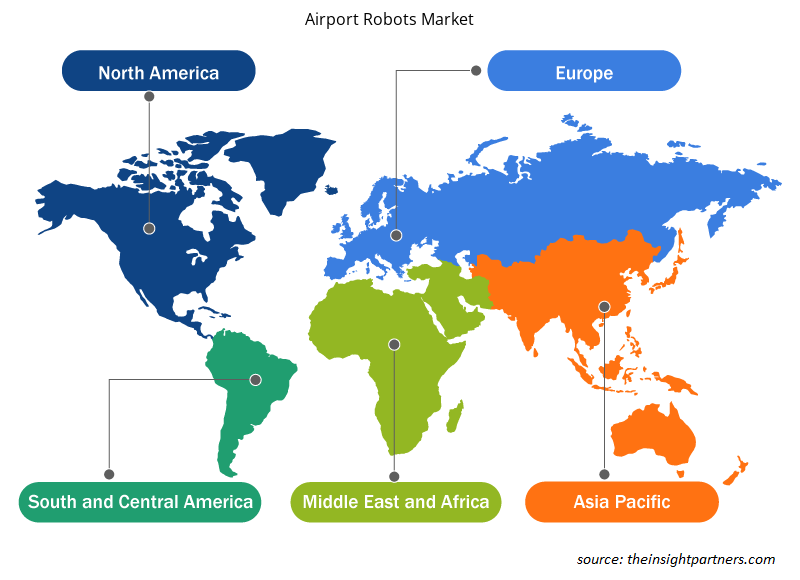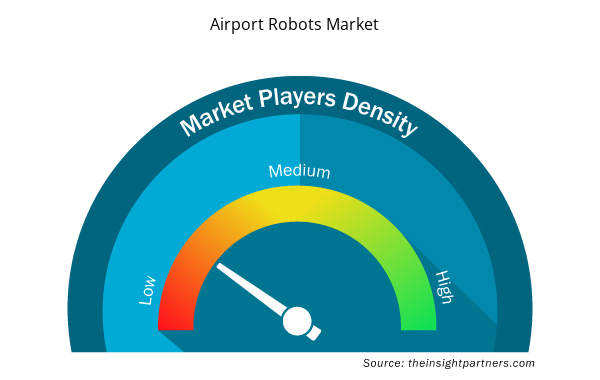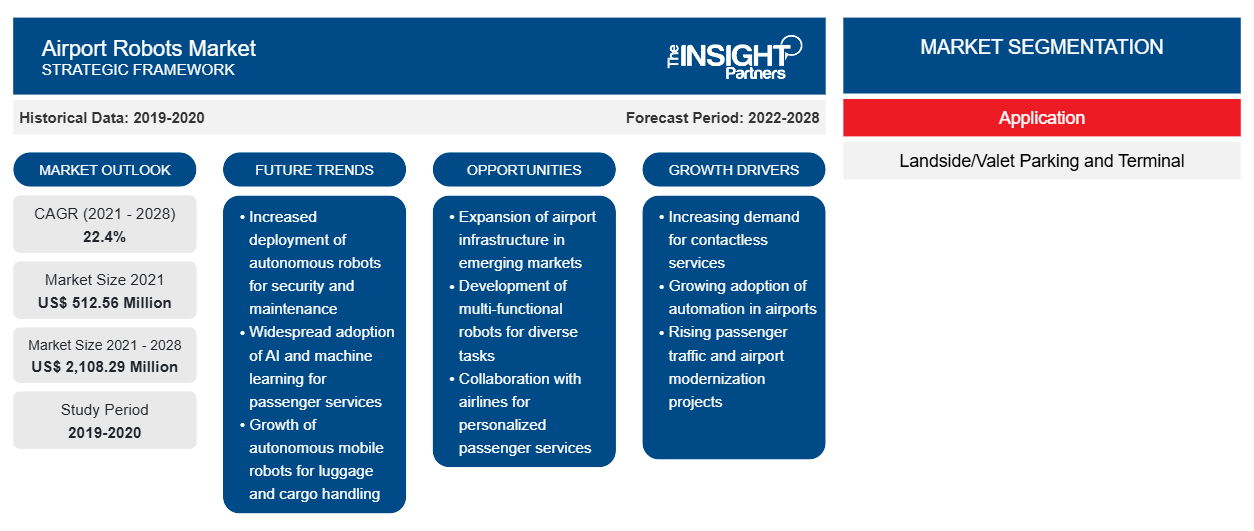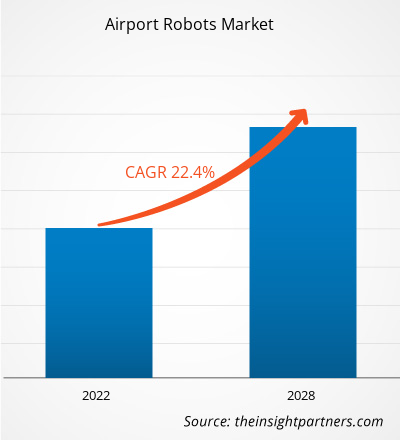[調査レポート] 空港ロボット市場は、2021年の5億1,256万米ドルから2028年には21億829万米ドルに成長すると予想されており、2021年から2028年にかけて22.4%のCAGRで成長すると予測されています。
国家安全保障に対する現実の脅威および認識された脅威の増加に伴い、これらの脅威を特定するための革新的な能動的な尋問アプローチを考案するための継続的な取り組みが行われています。最も差し迫った認識された脅威とその主な物質は、従来の爆発物、武器、化学剤、禁制品です。不確実な出来事を防ぐ目的で、世界中の当局は、空港のセキュリティを強化するために、ロボットを含む高度なシステムの導入に積極的に取り組んでいます。空港のセキュリティアプリケーションに使用されるロボットには、顔認識システム、センサー、遠隔で脈拍を測定するカメラなどの機能が統合されており、空港での業務や乗客の流れを妨げることなく、不審者、通貨、武器や爆発物、放棄された物体、その他の違法な物質を検出できます。さらに、さまざまな国の政府は、新しい空港の建設を含む輸送インフラの開発に投資しています。たとえば、中国政府は2035年までにさらに215の空港を建設する計画です。さらに、インド政府は2024年までに全国に100の新しい空港を建設する計画です。
要件に合わせてレポートをカスタマイズする
このレポートの一部、国レベルの分析、Excelデータパックなど、あらゆるレポートを無料でカスタマイズできます。また、スタートアップや大学向けのお得なオファーや割引もご利用いただけます。
- このレポートの主要な市場動向を入手してください。この無料サンプルには、市場動向から見積もりや予測に至るまでのデータ分析が含まれます。
COVID-19パンデミックが空港ロボット市場に与える影響
COVID-19パンデミックとそれに伴う封じ込め対策により、製造プロセスが一時的に停止したため、2020年の空港ロボット市場にはわずかな影響が出ました。しかし、2020年第3四半期から製造プロセスが徐々に再開され、空港ロボットの需要が増加し始め、メーカーは全体的な収益とキャッシュフローを安定させることができました。
空港ロボット市場の洞察
高度なロボットの需要増加が空港ロボット市場の成長を促進
OEM は、クラス最高の高度なロボットを開発するために研究開発に投資してきました。過去 10 年間、空港では毎日膨大な歩行者数が発生しており、空港ではさまざまな業務の最適化が求められています。多くの企業がこれらの業務を簡素化する空港ロボットを提供しているため、空港は労働力を最適化し、運用パフォーマンスを向上させ、リスクを軽減し、旅行者の体験を向上させるために自律型ロボットの導入に重点を移しています。その結果、多くの空港は、セキュリティ、荷物処理、乗客の案内、清掃などの用途にクラス最高の高度なロボットを提供できるロボット サプライヤーとの提携を期待しています。
アプリケーションベースの市場分析
空港ロボット市場は、用途別に、ランドサイド/バレットパーキングとターミナルに分かれています。ターミナルセグメントは、2020年に空港ロボット市場をリードしました。空港ターミナルは、着陸時に乗客が到着し、飛行機で出発する空港の建物です。通常、ターミナルにはいくつかのゲートがあり、ショッピング、ダイニング、トイレ、ラウンジ、その他の施設が揃ったコンコースと呼ばれるセクションに分かれています。ターミナルの乗客は、チケットを購入したり、予定されているフライトにチェックインしたり、荷物を預けたり、受け取ったり、セキュリティや税関を通過したり、乗り継ぎ便を探したりすることができます。
空港ロボット市場で活動する企業は、市場での地位を維持するために、合併や買収、市場イニシアチブなどの戦略に重点を置いています。主要企業によるいくつかの開発を以下に示します。
- 2021年、SITAはヴァーツラフ・ハヴェル・プラハ空港に次世代の旅客処理インフラの設置を完了し、完全にタッチレスでモバイル化された将来の旅客の旅への道筋を確立したと発表しました。
- 2020年には、スタンレー・ロボティクスとヴァンシ・エアポートが建設した、ロボットが完全に運営する世界初の屋外駐車場の展開がリヨン空港で継続され、利用可能な場所の数は500から2,000に拡大する予定です。7台の自律型ロボットが同時にサービスを運営し、車両の降車と乗車に利用できるキャビンは28個になります。
空港ロボット市場の地域別分析
予測期間を通じて空港ロボット市場に影響を与える地域的な傾向と要因は、Insight Partners のアナリストによって徹底的に説明されています。このセクションでは、北米、ヨーロッパ、アジア太平洋、中東、アフリカ、南米、中米にわたる空港ロボット市場のセグメントと地理についても説明します。

- 空港ロボット市場の地域別データを入手
空港ロボット市場レポートの範囲
| レポート属性 | 詳細 |
|---|---|
| 2021年の市場規模 | 5億1,256万米ドル |
| 2028年までの市場規模 | 21億829万米ドル |
| 世界のCAGR(2021年~2028年) | 22.4% |
| 履歴データ | 2019-2020 |
| 予測期間 | 2022-2028 |
| 対象セグメント | アプリケーション別
|
| 対象地域と国 | 北米
|
| 市場リーダーと主要企業プロフィール |
|
市場プレーヤーの密度:ビジネスダイナミクスへの影響を理解する
空港ロボット市場は、消費者の嗜好の変化、技術の進歩、製品の利点に対する認識の高まりなどの要因により、エンドユーザーの需要が高まり、急速に成長しています。需要が高まるにつれて、企業は提供を拡大し、消費者のニーズを満たすために革新し、新たなトレンドを活用し、市場の成長をさらに促進しています。
市場プレーヤー密度とは、特定の市場または業界内で活動している企業または会社の分布を指します。これは、特定の市場スペースに、その規模または総市場価値と比較して、どれだけの競合相手 (市場プレーヤー) が存在するかを示します。
空港ロボット市場で活動している主要企業は次のとおりです。
- 株式会社ユージンロボット
- アビドボッツ株式会社
- サイバーダイン株式会社
- ソフトバンクロボティクス
- スタンレーロボティクスSAS
免責事項:上記の企業は、特定の順序でランク付けされていません。

- 空港ロボット市場のトップキープレーヤーの概要を入手
世界の空港ロボット市場は次のように分類されています。
空港ロボット市場 – 用途別
- ランドサイド/バレットパーキング
- ターミナル
空港ロボット市場 – 地域別
北米
- 私たち
- カナダ
- メキシコ
ヨーロッパ
- フランス
- ドイツ
- イタリア
- ロシア
- 英国
- その他のヨーロッパ
アジア太平洋(APAC)
- 中国
- インド
- 日本
- オーストラリア
- 韓国
- その他のアジア太平洋地域
中東・アフリカ(MEA)
- サウジアラビア
- アラブ首長国連邦
- 南アフリカ
- MEAの残り
南アメリカ(SAM)
- ブラジル
- SAMの残り
企業プロフィール
- 株式会社ユージンロボット
- アビドボッツ株式会社
- サイバーダイン株式会社
- ソフトバンクロボティクス
- スタンレーロボティクスSAS
- シータ
- ABB株式会社
- ECAグループ
- LGエレクトロニクス
- UVDロボット
- 過去2年間の分析、基準年、CAGRによる予測(7年間)
- PEST分析とSWOT分析
- 市場規模価値/数量 - 世界、地域、国
- 業界と競争環境
- Excel データセット


- Medical Second Opinion Market
- Vision Guided Robotics Software Market
- Small Satellite Market
- Mice Model Market
- Compounding Pharmacies Market
- Legal Case Management Software Market
- Artificial Intelligence in Healthcare Diagnosis Market
- Cosmetic Bioactive Ingredients Market
- Thermal Energy Storage Market
- Point of Care Diagnostics Market

Report Coverage
Revenue forecast, Company Analysis, Industry landscape, Growth factors, and Trends

Segment Covered
This text is related
to segments covered.

Regional Scope
North America, Europe, Asia Pacific, Middle East & Africa, South & Central America

Country Scope
This text is related
to country scope.
よくある質問
Original equipment manufacturers (OEMs) have been investing in research and development (R&D) to develop best in class and advanced robots. Enormous daily foot traffic experienced by airports over the last decade is compelling them to optimize various operations at airports. With many companies offering airport robots for simplifying these operations, = airports are shifting their focus on adopting autonomous = robots to optimize labor, enhance operational performance, mitigate risk, and improve traveler experiences. As a result, many of them are looking forward to partnering with robot suppliers that can offer the best in class advanced robots for applications such as security, luggage handling, passenger guidance, and cleaning. Moreover, airports are facing issues in terms of significantly rising labor costs as well as the shortage of qualified, experienced, and reliable employees. Thus, the burgeoning complexity of airport operations is resulting in overburdening of existing personnel, compelling them to make tradeoffs between the quantity and quality of their work, which might hamper their reputation. To address this issue, airports are switching toward more advanced and autonomous robots that not only reduce the burden on personnel, but also work more efficiently than humans, without facing the issues such as excessive workload and fatigue.
Developing countries have become a hub of opportunities for various markets, including airport robots market. Government authorities in these countries are planning and investing huge amount in the advancement of technologies to improve the overall infrastructure. Transportation and logistics activities are huge contributors to the development of any country, and therefore, developing countries are extensively focusing on enhancing and improving their transportation and logistics infrastructure, including air, road, and sea transport. Airways is an important mode of transportation; hence, governments of developing countries have planned development and revamping of various mid-size and large airports. For instance, in India, Netaji Subhas Chandra Bose International Airport in Kolkata has laid down expansion plan of the airport. Similarly, Vietnam is planning to build one of the largest airports near its economic hub Ho Chi Minh City. Other developing countries including the Philippines and Kuwait are also expanding and revamping airports. As a part of expansion and revamping strategy, these airports would also be passing tenders on acquiring technologically advanced equipment including robots for ensuring convenience and providing superior experience to passengers. Hence, the airport robot market players have huge opportunities to offer best-in-class, and highly reliable and cost-efficient robots for such new airport projects.
The terminal segment led the airport robots market with a share of 74.8% in 2020. It is further expected to account for 77.0% of the total market by 2028.
The airport robots market is led by terminal segment with highest share and is expected to dominate in the forecast period. An airport terminal is a building at an airport where passenger arrive upon landing and depart on a flight. Typically, terminals have several gates divided into sections known as concourses that are filled with shopping, dining, restroom, lounge, and other facilities. Passengers at terminals can purchase tickets, check in for the scheduled flight, check or collect luggage, pass through security or customs, find connecting flights, and others.
ABB Ltd; Cyberdyne Inc.; LG Electronics Inc.; SoftBank Corp.; and Stanley Robotics SAS are among the key companies with significant market share.
The overall cost of procuring and maintaining advanced robots is quite high, which limits their adoption at airport, especially in cost-sensitive countries. These robots require frequent maintenance and servicing, which adds to the overall operating cost of running an airport. Airport deploy a large number of such advanced systems for various operations, based on the size and the requirement of the airport, and with the multiple deployments, the overall procurement and maintenance cost increases further. Small airports, operating in developed and developing countries, therefore, resist deploying such high-end robots and rely on conventional practices. Considering this restraint, airport robot manufacturers need to focus on offering a range of robots, starting from low end to high end, without compromising on the incorporation of the necessary and vital features in the low- and mid-range robots. The COVID-19 pandemic has changed the ways of operations of various sectors, including the transportation sector and airport industry. Airport authorities are willing to deploy autonomous robots to, ultimately, meet the social distancing norms imposed by the respective governments; however, the initial costs and maintenance costs are limiting their investments in robotic solutions.
Trends and growth analysis reports related to Electronics and Semiconductor : READ MORE..
The List of Companies - Airport Robots Market
- YUJIN ROBOT Co., Ltd.
- Avidbots Corp.
- CYBERDYNE INC.
- SoftBank Robotics
- Stanley Robotics SAS
- SITA
- ABB Ltd
- ECA Group
- LG Electronics
- UVD ROBOTS
The Insight Partners performs research in 4 major stages: Data Collection & Secondary Research, Primary Research, Data Analysis and Data Triangulation & Final Review.
- Data Collection and Secondary Research:
As a market research and consulting firm operating from a decade, we have published and advised several client across the globe. First step for any study will start with an assessment of currently available data and insights from existing reports. Further, historical and current market information is collected from Investor Presentations, Annual Reports, SEC Filings, etc., and other information related to company’s performance and market positioning are gathered from Paid Databases (Factiva, Hoovers, and Reuters) and various other publications available in public domain.
Several associations trade associates, technical forums, institutes, societies and organization are accessed to gain technical as well as market related insights through their publications such as research papers, blogs and press releases related to the studies are referred to get cues about the market. Further, white papers, journals, magazines, and other news articles published in last 3 years are scrutinized and analyzed to understand the current market trends.
- Primary Research:
The primarily interview analysis comprise of data obtained from industry participants interview and answers to survey questions gathered by in-house primary team.
For primary research, interviews are conducted with industry experts/CEOs/Marketing Managers/VPs/Subject Matter Experts from both demand and supply side to get a 360-degree view of the market. The primary team conducts several interviews based on the complexity of the markets to understand the various market trends and dynamics which makes research more credible and precise.
A typical research interview fulfils the following functions:
- Provides first-hand information on the market size, market trends, growth trends, competitive landscape, and outlook
- Validates and strengthens in-house secondary research findings
- Develops the analysis team’s expertise and market understanding
Primary research involves email interactions and telephone interviews for each market, category, segment, and sub-segment across geographies. The participants who typically take part in such a process include, but are not limited to:
- Industry participants: VPs, business development managers, market intelligence managers and national sales managers
- Outside experts: Valuation experts, research analysts and key opinion leaders specializing in the electronics and semiconductor industry.
Below is the breakup of our primary respondents by company, designation, and region:

Once we receive the confirmation from primary research sources or primary respondents, we finalize the base year market estimation and forecast the data as per the macroeconomic and microeconomic factors assessed during data collection.
- Data Analysis:
Once data is validated through both secondary as well as primary respondents, we finalize the market estimations by hypothesis formulation and factor analysis at regional and country level.
- Macro-Economic Factor Analysis:
We analyse macroeconomic indicators such the gross domestic product (GDP), increase in the demand for goods and services across industries, technological advancement, regional economic growth, governmental policies, the influence of COVID-19, PEST analysis, and other aspects. This analysis aids in setting benchmarks for various nations/regions and approximating market splits. Additionally, the general trend of the aforementioned components aid in determining the market's development possibilities.
- Country Level Data:
Various factors that are especially aligned to the country are taken into account to determine the market size for a certain area and country, including the presence of vendors, such as headquarters and offices, the country's GDP, demand patterns, and industry growth. To comprehend the market dynamics for the nation, a number of growth variables, inhibitors, application areas, and current market trends are researched. The aforementioned elements aid in determining the country's overall market's growth potential.
- Company Profile:
The “Table of Contents” is formulated by listing and analyzing more than 25 - 30 companies operating in the market ecosystem across geographies. However, we profile only 10 companies as a standard practice in our syndicate reports. These 10 companies comprise leading, emerging, and regional players. Nonetheless, our analysis is not restricted to the 10 listed companies, we also analyze other companies present in the market to develop a holistic view and understand the prevailing trends. The “Company Profiles” section in the report covers key facts, business description, products & services, financial information, SWOT analysis, and key developments. The financial information presented is extracted from the annual reports and official documents of the publicly listed companies. Upon collecting the information for the sections of respective companies, we verify them via various primary sources and then compile the data in respective company profiles. The company level information helps us in deriving the base number as well as in forecasting the market size.
- Developing Base Number:
Aggregation of sales statistics (2020-2022) and macro-economic factor, and other secondary and primary research insights are utilized to arrive at base number and related market shares for 2022. The data gaps are identified in this step and relevant market data is analyzed, collected from paid primary interviews or databases. On finalizing the base year market size, forecasts are developed on the basis of macro-economic, industry and market growth factors and company level analysis.
- Data Triangulation and Final Review:
The market findings and base year market size calculations are validated from supply as well as demand side. Demand side validations are based on macro-economic factor analysis and benchmarks for respective regions and countries. In case of supply side validations, revenues of major companies are estimated (in case not available) based on industry benchmark, approximate number of employees, product portfolio, and primary interviews revenues are gathered. Further revenue from target product/service segment is assessed to avoid overshooting of market statistics. In case of heavy deviations between supply and demand side values, all thes steps are repeated to achieve synchronization.
We follow an iterative model, wherein we share our research findings with Subject Matter Experts (SME’s) and Key Opinion Leaders (KOLs) until consensus view of the market is not formulated – this model negates any drastic deviation in the opinions of experts. Only validated and universally acceptable research findings are quoted in our reports.
We have important check points that we use to validate our research findings – which we call – data triangulation, where we validate the information, we generate from secondary sources with primary interviews and then we re-validate with our internal data bases and Subject matter experts. This comprehensive model enables us to deliver high quality, reliable data in shortest possible time.


 このレポートの無料サンプルを入手する
このレポートの無料サンプルを入手する